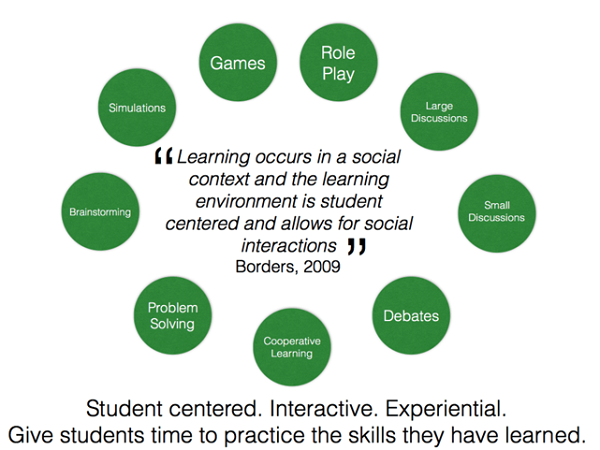5 Steps for Energizing Your Health Class
By Andrew Milne | August 29, 2017
Health Education & PE Teacher, New Trier High School
Teaching health is a fantastic opportunity! What a privilege to get to encourage our students to consider their health and that of others.
With increased pressure on academic scheduling it's important that health educators get the most out of their time in the classroom. These 5 steps should have your students running to your class, eager to learn.
1. Set the Tone (Bell Ringers and Provocations)
You've greeted your students at the door, perhaps even by name, but once they sit down it's important to turn up the energy level. Effective teachers might use social bell ringers, trivia questions, and even classroom contests. My own preference is the use of provocations—activities to challenge the thinking of my students.
This use of cognitive dissonance encourages students to consider their views and beliefs. It challenges them sufficiently enough to motivate them to want to learn more. (See this Twitter conversation for an example.)
2. Keep It Social (Student-Centered Environment)
Health doesn't happen in isolation. As health educators continue their move away from content-led curricula towards skills-based curricula, it's more important than ever that we encourage our students to work with each other.
If the thought of allowing your students to lead their own learning is daunting, consider introducing more of the activities identified in the diagram below. These ideas are taken from a presentation that I give regularly on engaging students in the classroom. All of these strategies provide engaging opportunities for our students to practice their health skills repeatedly in a safe environment—one where it's ok to take risks and make mistakes on the journey towards health literacy.

The quote is from this article by M. J. Borders. The ideas in the diagram are based on my reading of Benes & Alperin’s book, The Essentials of Teaching Health Education.
3. Keep it Relevant (Make the Content Speak to Your Students)
Many times our text books don't speak to our students. Even our own health stories don't always resonate with teenagers. When looking for a “hook” to get students engaged in health class, I have found that using Youth Risk Behavior Survey data is one of the most effective ways to engage inquisitive learners.
My classes discuss sensitive topics such as relationship safety, bullying, stress and anxiety, depression and suicide, substance use and sexual activity. The ability to provide students with accurate data reflecting the behavior of their peers allows me to focus both their attention and my teaching.
Sharing peer data allows me to challenge students’ perceptions of their behavior and that of their peers. It allows me to shape my curriculum to the specific needs of my students. It identifies those health areas of concern that students can choose to advocate for.
This last point also allows me to tap into the passions of my students. While I'm still teaching the skill of advocacy, I allow the students to show their evidence of learning and understanding by applying those skills to the health concern about which they care most deeply.
Check out this podcast I recorded with Charlie Rizzuto on the topic of using YRBS data to create meaningful learning experiences for your students.
4. Go Beyond the Classroom (Peers, Home, Community Advocates)
As educators, we must no longer be satisfied with our students providing us with evidence of learning within the four walls of our classroom. It is important that our students feel confident in taking the health message back to their peers and those at home. We want them to encourage others to improve their health-enhancing behaviors and reduce risk.
Health isn't just a one semester class that we learn in school. It's a life skill and a journey. In fact, I often quote a student whom I taught many years ago when he said the following:
In health, it's not just about getting an A in the class, it's about getting an A in life.
- Ryan Jones
It is important that our students are able to provide help for others in terms of health. That includes looking at their communities, considering who might be less advantaged, then stepping up to advocate alongside them for better health provision. This fact also allows us to have powerful social justice conversations in the classroom, and that can never be a bad thing.
5. Remember That Sharing is Caring (Harness the Power of Social Media)
One benefit of technology that I love is its ability to give students a greater audience. When our students create great work for us, it’s only fair that multiple eyes get to see it. We should share these examples with other students, other teachers, and even, with permission, share it on social media.
Imagine the sense of pride that students feels when they start to see a tweet of their work, or a great quote of theirs bounce around in cyber space with a life of it’s own. There’s a wonderful quote from Rushton Hurley that I have saved as my desktop image on my laptop:

I’ve had students turn in a great piece of work, an A grade for sure, and I’ll say, “This is amazing! I want to tweet this out to my people on Twitter.”
At which point they’ll say, “Wait. If that’s the case, give it back to me so that I can make it even better.” How often do you hear of students doing that? “Give me my A grade work so that I can make it even better than the best grade possible anyway.”
And yes, it works! I once shared a student quote about bullying online: “Sending or posting something online is like a scar—even when it fades, it’s still there.” That quote was picked up by a bullying charity in Canada and retweeted. We then saw that tweet bounce around Canada for a few days.
The student quote I shared earlier, from Ryan Jones, is now quoted back to me online at times when the topic of lifelong health is raised on Twitter.
Once you start collating all of this great evidence of student work, it starts to motivate other students and raise standards. If I take the best piece of work that I’ve seen from my semester 1 students, and share that with semester 2...Well, if that’s all they have to go on, that becomes the baseline.
Each student in semester 2 aims to better the best I’ve seen from the previous semester. Now we’ve got peers teaching peers, at which point I get to step back, be the guide on the side, and just facilitate the learning. Student-created images, quotes, posters, iMovies, podcasts, and PSA's can all be shared to a global audience. We recently collaborated with a school in Tasmania to share podcasts.
These not only highlight the great work going on in the classroom. They also stand as evidence of effective teaching and proof of the ways enhancing the learning experience for our students can increase energy and engagement.
My List is Longer
Obviously, this list of 5 steps is short. I could write at length of other strategies that work for me in the health classroom, that increase motivation and energy, and make my room one where students enjoy learning. But I'd love to hear from you. What is your go-to tip for energizing your health class?
Help Send a Teacher to the 2018 SHAPE Conference in Nashville

I am fortunate to work at a school that sends me to education conferences with their blessing, but many teachers do not have this support. I’ve created the Send-a-Teacher fundraiser to raise funds to send one or two teachers to the #SHAPENashville 2018 convention. Buy a cool T-shirt or just send us a donation if you’d like. Learn more here.
Andrew Milne is a health education and PE teacher at New Trier High School in Illinois. He is also the host of the #slowchathealth blog and the ongoing #slowchathealth Twitter conversations (@carmelhealth), not to mention the Shape America Health Education Teacher of the Year for 2017. He provides support and professional development to teachers all around the globe. He can be reached at milnea@nths.net.





